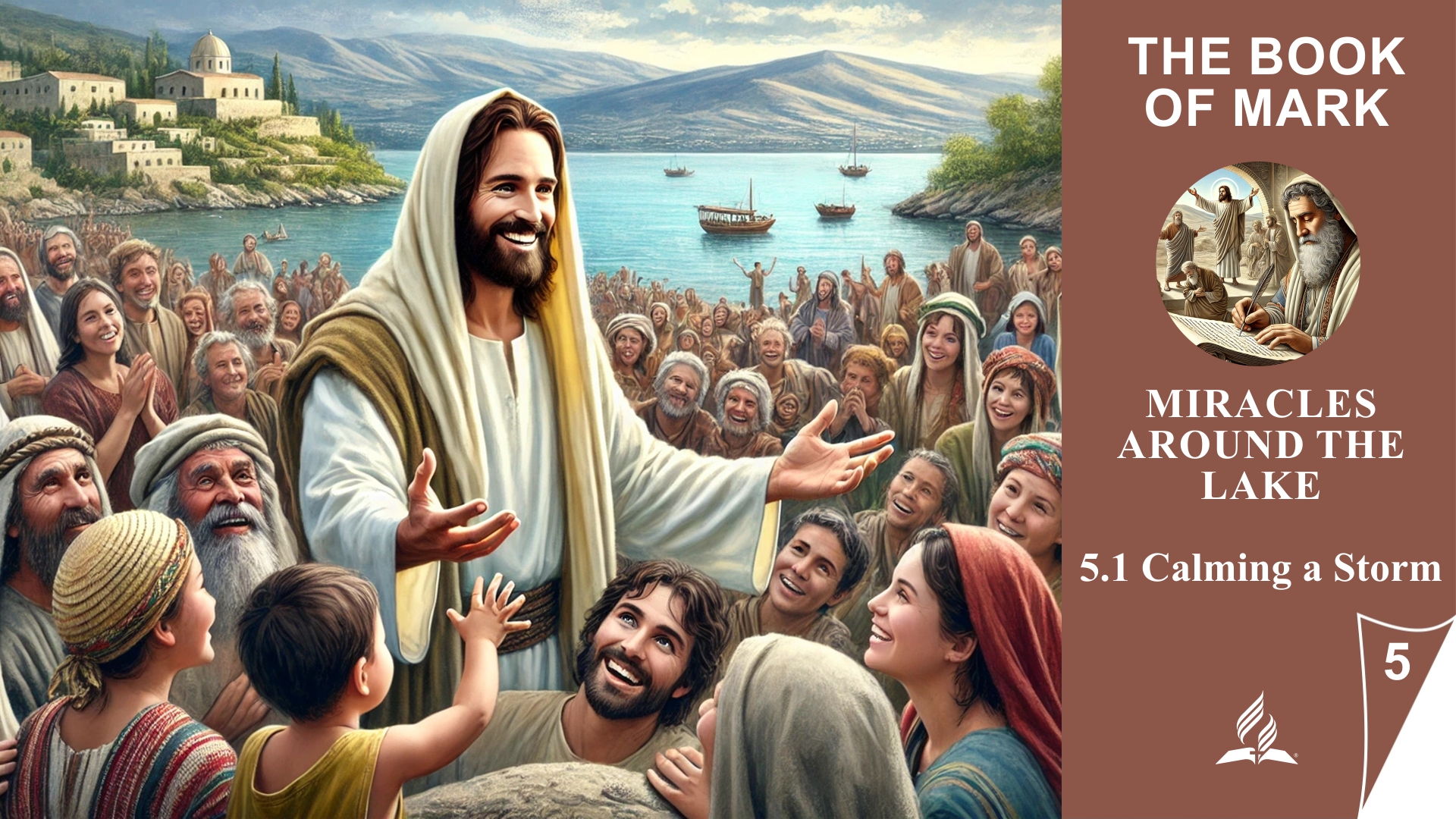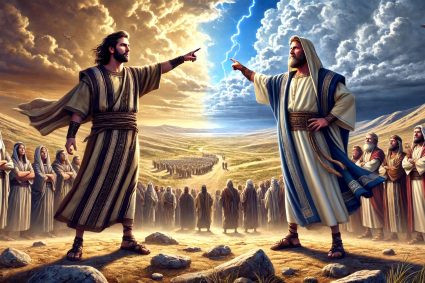


Lesson 5.Miracles Around the Lake
Jesus’ Miracles at the Sea of Galilee: Revelation of His Divine Power and Mercy
Welcome to Lesson 5, where we delve deeply into the Gospel of Mark to better understand the nature and mission of Jesus and to discover how the people of his time responded to him. This lesson takes us through some of the most impressive and significant events in Jesus’ life, which not only reveal his divine power and authority but also highlight the misunderstandings and challenges associated with his mission.
In this lesson, we will explore the following stories and themes:
-
Calming of the Storm (Mark 4:35–41):
-
This story shows Jesus’ power over the forces of nature and teaches us the importance of trusting him in the storms of our lives.
-
-
Healing of the Demon-Possessed Man (Mark 5:1–20):
-
Here we see Jesus’ authority over evil and his ability to bring deliverance and healing, even in the most hopeless situations.
-
-
Healing of the Bleeding Woman and Raising of Jairus’ Daughter (Mark 5:21–43):
-
These stories reveal the deep faith and desperation of the people who seek out Jesus and show his power to bring both physical and spiritual healing.
-
-
Rejection in Nazareth (Mark 6:1–6):
-
This episode highlights how difficult it was for even those who knew Jesus best to accept his true identity and mission.
-
-
Sending Out the Twelve Apostles and the Beheading of John the Baptist (Mark 6:7–30):
-
These accounts stand in stark contrast to each other and illustrate the challenges and dangers of proclaiming the gospel.
-
-
Miraculous Feeding of the 5000 and Jesus Walking on Water (Mark 6:34–52):
-
These miracles demonstrate Jesus’ care and divine nature while challenging and correcting the people’s expectations of the Messiah.
-
As we examine these stories, we will compare the popular notions of the Messiah in Jesus’ time with the true mission he fulfilled. This lesson helps us understand why a correct understanding of prophecy is important and how misunderstandings about Jesus’ mission can lead to confusion and rejection. It will encourage us to deepen our faith, reassess our expectations of God’s actions, and trust in his guidance and care in our daily lives.
Let’s discover together how these timeless lessons can shape our lives and faith today.

5.1 Calming a Storm
Jesus’ Power Over Nature: Calming the Storm as a Sign of His Divinity
Read Mark 4:35–41. What happens in this story and what can we learn about Jesus from it?
In Mark 4:35–41, a dramatic event gives us deeper insights into the nature and work of Jesus. After a long day of teaching, Jesus and his disciples get into a boat to cross to the other side of the lake. Exhausted from the day’s efforts, Jesus falls asleep in the stern of the boat. During the crossing, a sudden and fierce storm arises, threatening to capsize the boat. The frightened disciples wake Jesus and ask for his help. With just a few words, Jesus commands the wind and waves to calm down, and immediately a great calm ensues.
This story highlights several important aspects of Jesus and his nature:
-
Human Nature of Jesus: Jesus was tired after a long day and needed rest. This human side shows his connection to our everyday experiences and weaknesses.
-
Divine Authority of Jesus: By commanding the wind and waves, Jesus reveals his divine nature. This demonstration of supernatural control over the forces of nature affirms his identity as the Son of God.
-
Faith and Trust: The disciples’ reaction, asking Jesus for help despite their fear, shows their faith in his abilities but also their uncertainty and doubt. Jesus questions their fear and lack of faith, encouraging them to strengthen their trust in him.
-
Fear and Awe: The disciples’ response after the miracle— a mixture of fear and awe—underscores their realization of the overwhelming divine presence among them. They wonder who this man is that even the wind and waves obey him.
Overall, this story teaches us that Jesus is both fully human and fully God. His power over nature reminds us that we can trust him in all the storms of our lives. This narrative encourages us to deepen our faith and rely on Jesus in times of need, knowing that he has the power to handle any challenge.
Read Psalm 104:1–9. How can the image of Yahweh here be compared to the calming of the storm by Christ?
Psalm 104:1–9 paints a majestic picture of Yahweh as the creator and ruler over nature. The psalmist describes how God clothes himself with light, stretches out the heavens like a tent, and sets the earth on its foundations so that it cannot be moved. He commands the waters to retreat, revealing the mountains and valleys. This depiction of God’s power and glory emphasizes his control over all creation.
This portrayal of Yahweh in Psalm 104 can be impressively compared to the calming of the storm by Christ in Mark 4:35–41. In both cases, the sovereign power of God over nature is highlighted. Here are some central points of comparison:
-
Divine Power over Nature: Both in the psalm and the gospel, the unrestricted authority of God over the elements of nature is emphasized. While Psalm 104 describes Yahweh’s comprehensive creative power, Mark 4 shows how Jesus, through his word, calms the forces of nature. This reveals Jesus as the one who possesses the same power as the Creator.
-
Theophany and Divine Appearance: Both texts contain elements of a theophany. Psalm 104 describes God in his glory and power, made visible through creation. In Mark 4, Jesus demonstrates his divine nature and power through the miracle, evoking fear and awe among the disciples.
-
Fear and Trust: In both stories, people respond with fear to the manifestation of divine power. The disciples are terrified and ask, “Who is this? Even the wind and the waves obey him!” This fear points to a deeper understanding and recognition of Jesus’ divine power.
-
Revelation and Mystery: While Psalm 104 reveals the majesty and glory of God explicitly, the calming of the storm lacks an explicit explanation of the revelation. This fits into the Gospel of Mark, which often emphasizes the mystery surrounding Jesus’ identity. The disciples’ question, “Who is this?” invites the reader to seek the answer and understand the deeper meaning of Jesus’ divine power—that he is the Son of God.
Overall, Psalm 104 and Mark 4:35–41 both emphasize the overwhelming power and glory of God over nature. Jesus’ calming of the storm fits into the biblical pattern of theophany and reveals his identity as the divine ruler who has power over creation. This parallel invites us to recognize in Jesus the one who stands in perfect unity with the Creator and shares his power and glory.
Reflect on God’s power. How can you learn to rely on this power and trust it in all things in your life?
Reflecting on God’s power is a profound spiritual practice that can help us strengthen our trust and dependence on God in all areas of life. Here are some steps and considerations on how to learn to rely on God’s power and trust in it:
-
Daily Devotion and Prayer:
-
Reflection and Meditation: Start and end your day with prayer and meditation on God’s power and greatness. Read the Bible and focus on passages that highlight God’s power and care, such as Psalm 104 or Mark 4:35–41.
-
Expressing Gratitude: Consciously thank God for his omnipotence and the ways he works in your life. Gratitude helps strengthen trust in his constant presence and help.
-
-
Recognizing God’s Actions in Your Life:
-
Reflecting on Past Experiences: Think about situations in your life where you have felt God’s power and guidance. Write these experiences down and read them regularly to remind yourself of his faithfulness.
-
Current Challenges: Recognize that current difficulties are also opportunities to experience God’s power. Trust that he is present in every situation and has control.
-
-
Trust through Community:
-
Collective Prayer: Pray with other believers, whether in church, prayer groups, or informal gatherings. Collective prayer can strengthen trust in God’s power and encourage you to wait for his help.
-
Sharing Testimonies: Listen to and share stories and testimonies of God’s work in your life and the lives of others. These stories can deepen your trust and faith in his power.
-
-
Faith through Action:
-
Faith in Action: Put your faith into practice through concrete actions. This can mean serving others, listening to God’s guidance, and making bold decisions based on his word.
-
Trust in God’s Plan: Even when circumstances are uncertain, trust that God’s plan is greater and better than our own understanding. Learn to let go and leave control to God.
-
-
Continuous Spiritual Education:
-
Bible Study: Deepen your understanding of scripture through regular Bible study. Look for lessons and examples that testify to God’s power and faithfulness.
-
Teaching and Sermons: Participate in teachings and sermons that strengthen your trust in God’s power and guidance. Let yourself be guided by the wisdom and experience of others.
-
In summary, learning to rely on God’s power and trust in it involves building a conscious and continuous relationship with him. It requires daily devotion, recognizing and remembering his actions in your life, experiencing community with other believers, actively living out your faith, and continuous spiritual education. Through these steps, your trust in God’s almighty guidance can grow and strengthen you in all things in life.

The story of the calming of the storm in Mark 4:35–41 and Psalm 104:1–9 offer profound insights into the divine power and glory of Jesus, which directly impact our daily lives and faith. Here are some ways we can apply these biblical truths to our everyday lives:
-
Trust in God’s Power in Challenges:
-
Daily Storms: Everyone faces challenges and crises in life, whether health problems, professional difficulties, or personal conflicts. The story shows that Jesus has the power to calm even the fiercest storms. This reminds us that we can trust Jesus in our daily “storms.”
-
Prayer and Trust: In difficult times, we should come to Jesus in prayer and entrust our fears and worries to him. He has the power to bring peace and calm to our stormy situations.
-
-
Recognizing and Accepting God’s Presence:
-
God’s Presence in Everyday Life: The disciples had Jesus in their boat but were not fully aware of his power. We too often feel alone, forgetting that God is always with us. By consciously recognizing that Jesus is always present, we can find more peace and security in our everyday lives.
-
Reverence and Gratitude: Like the disciples, we should respond with reverence and gratitude when we recognize God’s presence and power. This can be done through daily thanksgiving and praise.
-
-
Deepening Faith and Trust:
-
Faith Growth through Challenges: Jesus questioned the disciples’ faith to strengthen their trust in him. We too should see challenges as an opportunity to deepen our faith and strengthen our trust in God’s power.
-
God’s Word as a Foundation: By studying the Bible and meditating on God’s promises, we can strengthen our trust in his power and care. Psalm 104 and Mark 4 remind us of how great and mighty God is.
-
-
Community and Support:
-
Shared Faith: The disciples experienced the storm together and found comfort in Jesus together. We too should stand in community with other believers to encourage and support each other.
-
Sharing Experiences: Sharing experiences of how God has worked in our lives can help others strengthen their trust in God’s power.
-
-
Rest in God’s Sovereignty:
-
Calm and Peace: The fact that Jesus could sleep in the midst of the storm shows his complete calm and trust in God’s sovereignty. We too can learn to rest in God’s sovereignty and find calm even when circumstances are difficult.
-
Divine Perspective: By adopting a divine perspective and recognizing that God has everything under control, we can let go of our fears and worries and live in peace.
-
In summary, the story of the calming of the storm shows us that Jesus understands both human weaknesses and possesses divine power. This truth invites us to trust in his power in all situations of life, find rest in his presence, and deepen our faith. By relying on God’s sovereignty, we can be strengthened and encouraged in all areas of our lives.
Trust in the power and presence of Jesus in all the storms of your life, for his divine power can calm even the fiercest waves and give you peace.
(Visited 22 times, 1 visits today)





















